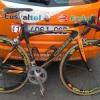All:
Yes -- under totally artificial conditionsThis is my favorite passage from the study:
**********
We note that unlike CR, resveratrol did not reduce circulating IGF-1 levels (Figure 2B), and there was also no decrease in spontaneous tumors at the time of sacrifice (Supplemental Table S2). In particular, spontaneous liver tumors were abundant in mice fed the control diet or resveratrol, but rare in CR mice. Thus, although a low dose of resveratrol can improve quality of life by retarding aging parameters such as cardiac dysfunction, a nutritional or pharmaceutical strategy to also increase lifespan in mice will likely require blockage of the IGF-1 axis or its targets.
***********
And yet RSV does appear to fight cancer at higher dosage levels, does it not?
The alleged benefits even of soy phytoestrogens, which are much better-studied in humans (because we have done more clinical trials and, more importantly, have a lot of prospective epidemiology) remain highly ambiguous. As I have written elsewhere (slight edits in version below):
******
soy phytoestrogens are protective against prostate cancer in some animal models (including (3), which closely mirrors this [resveratrol] study [2] in design (TRAMP mice, initiated on genistein at age 5-6 weeks)), but while a reduction in prostate cancer incidence has been observed in soy consumers in some epidemiological studies, an American Heart Association Nutrition Committee Science Advisory for professionals concluded that
The efficacy and safety of soy isoflavones for preventing or treating cancer of the breast, endometrium, and prostate are not established; evidence from clinical trials is meager and cautionary with regard to a possible adverse effect.(4)
Indeed, a prospective epidemiological study in Japan found that
This is especially important to note in the resveratrol prostate cancer study (2), since the animals began consuming a resveratrol-supplemented diet at age 5 weeks, as in the previous genistein report in the same model (3); this is at or only shortly after weaning (3-6 weeks), and before reproductive maturity (6-8 weeks). In this context, it is important to bear in mind the bimodal effects of soy phytoestrogens on breast cancer, depending on exposure times during the life cycle:Intakes of genistein, daidzein, miso soup, and soy food were not associated with total prostate cancer. However, these four items decreased the risk of localized [ie, noninvasive, generally non-life-threatening -MR] prostate cancer. In contrast, positive associations were seen between isoflavones and advanced prostate cancer.(4)
************We and others have shown that both genistein and resveratrol can protect against mammary cancer in rodents. The timing of exposure to genistein appears critical for its mammary protective effects. It has been reported that genistein early in life causes enhanced mammary gland differentiation, alterations in cell proliferation and apoptosis, and upregulation of tumor-suppressor genes. With resveratrol in the diet, changes in cell proliferation and apoptosis in terminal ductal structures of the mammary gland might help to explain its protective effects.(6)
Note this last point, which is especially important in considering the time of exposure:
Similar observations have been made in humans: childhood exposure to genistein in soy or to some other bioactive food components reduces later breast cancer risk, although they may have no effect if consumed during adulthood. ... Many of these dietary exposures modify fetal and postnatal hormonal environment, including changing the concentrations of estrogens and leptin. The hormonal alterations then may induce persistent epigenetic changes ... The targets of epigenetic changes are likely to be the terminal end buds (TEBs), the structures where carcinogen-induced mammary tumors in rats and mice are initiated. ... Similar structures in women, called terminal ductal lobular units, are the sites where most human breast cancers rise. ... It is possible that some of these epigenetic changes also explain why the number of TEBs generally, but not always, correlates with breast cancer risk. (5)
Returning to previously-posted materials:
*************
Some studies have found that, with high soy intake, estrogen metabolism is favorably altered and menstrual cycle length increased; however, the impact of these changes on breast cancer risk is uncertain. Considerable enthusiasm remains for the possibility that soyfood intake contributes to the low breast cancer rate in Asia but increasingly it appears that childhood and/or adolescence is the critical period of exposure. This hypothesis, which is supported by both epidemiologic and animal data, is consistent with the mounting evidence that early life events greatly impact breast cancer risk ...
In addition to the potential protective effects, some data suggest that isoflavones could promote breast cancer. In vitro, genistein stimulates the growth of estrogen-sensitive mammary cancer cells, and in ovariectomized athymic mice, dietary genistein and genistin stimulate the growth of existing estrogen-sensitive mammary tumors. Consequently, in recent years, the estrogen-like effects of isoflavones have raised concerns that soyfoods are contraindicated for women at high risk of breast cancer and breast cancer patients with estrogen-sensitive tumors — approximately two-thirds of women with postmenopausal breast cancer are in this category. Numerous review articles and commentaries have been published on this topic.(6)
Soy phytoestrogens may also promote endometrial hyperplasia, another estrogen-dependent phenomenon:
Three hundred seventy-six postmenopausal healthy women, all with intact uterus ... were distributed in two different groups using randomized criteria: group A (n = 179) patients received soy tablets (150 mg of isoflavones per day) for 5 years; group B (n = 197) patients received identical appearing placebo tablets for 5 years. ... Two hundred ninety-eight women completed the 5-year treatment. No cases of malignancy were detected during biopsy. Seventy percent of women undergoing treatment with soy phytoestrogens had an endometrium classified as atrophic or nonassessable versus 81% receiving placebo. The occurrence of endometrial hyperplasia was significantly higher in group A (3.37% vs. 0%). CONCLUSION(S): Long-term treatment (up to 5 years) with soy phytoestrogens was associated with an increased occurrence of endometrial hyperplasia. These findings call into question the long-term safety of phytoestrogens with regard to the endometrium.(13)
I submit, then, that based on the experimental design problems (administration to sexually immature animals and known interspecies differences between mice and (wo)man in resveratrol biotransformation) and the biphasic and ambiguous effects of phytoestrogens in human epidemiology, experiments examining resveratrol's effects in hormone-dependent cancer models provide very little confidence that resveratrol will treat or reduce the incidence of prostate or breast cancer, and indeed might even raise the specter of a cancer risk of resveratrol supplementation in mature humans, and especially in males.
************
The importance of this new, CR-versus-resveratrol study (7) is that it is the first and only study to last for most of the natural lifespan of the animal, and the only one that assesses the effects of resveratol under conditions relevant to anyone that doesn't live on an unremediated Superfund site; and it found, again, that
unlike CR, resveratrol did not ... [cause] decrease in spontaneous tumors at the time of sacrifice [30 months -- about 80 human years -MR]. In particular, spontaneous liver tumors were abundant in mice fed the control diet or resveratrol, but rare in CR mice.(7)
As noted above, in many in vivo cases, they quite intentionally lived short- lived mutants -- again, of little relevance to normal, healthy humans. And in the other studies, the animals were subjected to intentionally hideous conditions, and in any case the previous experiments have been so short that we really don't have a good idea as to whether the mice were properly cared-for in the first place, whereas Weindruch has a thirty year record of raising some of the healthiest control mice in biogerontology."Long-lived F1 hybrid mice" were used in the study. Are these particular "hybrid" mice similar, or substantially different, from mice used in other similar studies?
It seems increasingly reasonable to ask why the long-promised results lifespan studies in normal, nonobese mice from Sinclair's group (8) still have still not been released, a year and a half on (emphasis mine):
Silence, it seems, so far remains golden ...Cohorts of middle-aged (one-year-old) male C57BL/6NIA mice were provided with either a standard diet (SD) or an otherwise equivalent high-calorie diet (60% of calories from fat, HC) for the remainder of their lives. To each of the diets, we added resveratrol at two concentrations ... After 6 months of treatment, there was a clear trend towards increased survival and insulin sensitivity. Because the effects were more prominent in the higher dose (22.4 0.4 mg kg-1 day-1, [High-Calorie, High-Resveratrol group], we initially focused our resources on this [High-Calorie, High-Resveratrol group])group and present the results of those analyses herein. [i]Analyses of the other groups will be presented at a later date.(8)
-Michael
References
1. Whitsett TG Jr, Lamartiniere CA.
Genistein and resveratrol: mammary cancer chemoprevention and mechanisms of action in the rat.
Expert Rev Anticancer Ther. 2006 Dec;6(12):1699-706. Review.
PMID: 17181483 [PubMed - indexed for MEDLINE]
2. Harper CE, Patel BB, Wang J, Arabshahi A, Eltoum IA, Lamartiniere CA.
Resveratrol suppresses prostate cancer progression in transgenic mice.
Carcinogenesis. 2007 Sep;28(9):1946-53. Epub 2007 Aug 3.
PMID: 17675339 [PubMed - in process]
3. Mentor-Marcel R, Lamartiniere CA, Eltoum IE, Greenberg NM, Elgavish A.
Genistein in the diet reduces the incidence of poorly differentiated prostatic adenocarcinoma in transgenic mice (TRAMP).
Cancer Res. 2001 Sep 15;61(18):6777-82.
PMID: 11559550 [PubMed - indexed for MEDLINE]
4. Sacks FM, Lichtenstein A, Van Horn L, Harris W, Kris-Etherton P, Winston M; American Heart Association Nutrition Committee.
Soy protein, isoflavones, and cardiovascular health: an American Heart Association Science Advisory for professionals from the Nutrition Committee.
Circulation. 2006 Feb 21;113(7):1034-44. Epub 2006 Jan 17.
PMID: 16418439 [PubMed - indexed for MEDLINE]
5. Hilakivi-Clarke L.
Nutritional modulation of terminal end buds: its relevance to breast cancer prevention.
Curr Cancer Drug Targets. 2007 Aug;7(5):465-74. Review.
PMID: 17691906 [PubMed - indexed for MEDLINE]
6. Messina M, McCaskill-Stevens W, Lampe JW.
Addressing the soy and breast cancer relationship: review, commentary, and workshop proceedings.
J Natl Cancer Inst. 2006 Sep 20;98(18):1275-84. Review.
PMID: 16985246 [PubMed - indexed for MEDLINE]
7. Barger JL, Kayo T, Vann JM, Arias EB, Wang J, Hacker TA, Wang Y, Raederstorff D, Morrow JD, Leeuwenburgh C, Allison DB, Saupe KW, Cartee GD, Weindruch R, Prolla TA.
A low dose of dietary resveratrol partially mimics caloric restriction and retards aging parameters in mice.
PLoS ONE. 2008 Jun 4;3(6):e2264.
PMID: 18523577 [PubMed - in process]
8. Baur JA, Pearson KJ, Price NL, Jamieson HA, Lerin C, Kalra A, Prabhu VV, Allard JS, Lopez-Lluch G, Lewis K, Pistell PJ, Poosala S, Becker KG, Boss O, Gwinn D, Wang M, Ramaswamy S, Fishbein KW, Spencer RG, Lakatta EG, Le Couteur D, Shaw RJ, Navas P, Puigserver P, Ingram DK, de Cabo R, Sinclair DA.
Resveratrol improves health and survival of mice on a high-calorie diet.
Nature. 2006 Nov 16;444(7117):337-42. Epub 2006 Nov 1.
PMID: 17086191 [PubMed - indexed for MEDLINE]





















































